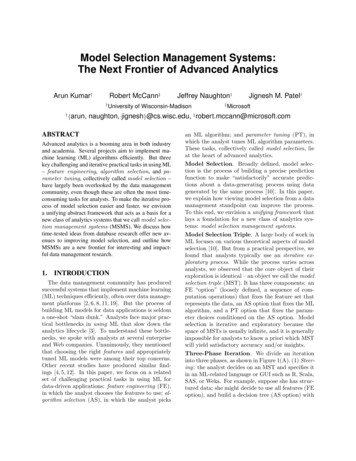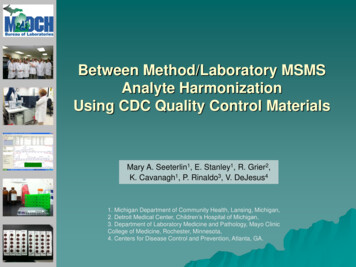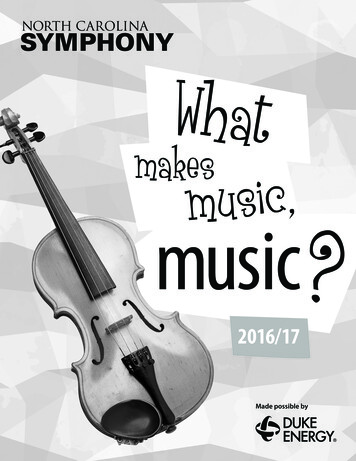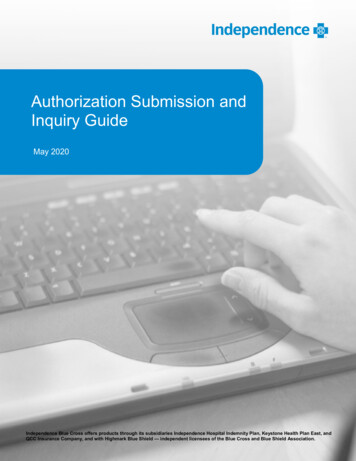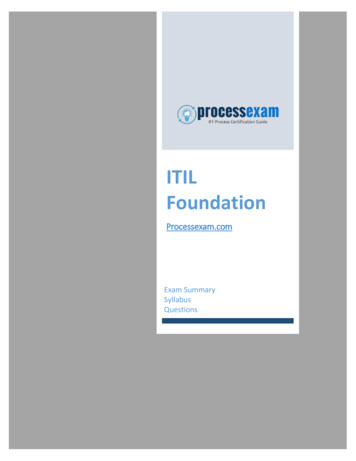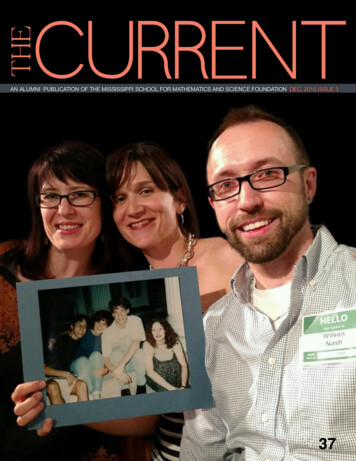
Transcription
THECURRENTAN ALUMNI PUBLICATION OF THE MISSISSIPPI SCHOOL FOR MATHEMATICS AND SCIENCE FOUNDATION DEC. 2016 ISSUE 337 i
A PUBLICATION OFTHE MSMS FOUNDATIONEXECUTIVE BOARD OF DIRECTORSMs. Cindy Henderson, Presidentcjhenderson@gmail.comMr. Chad F. Edmonson, Vice Presidentcedmonson@hotmail.com2Mr. Ryder Taff, Secretaryjrtaff@gmail.comMr. John Davis, Treasurerjohn.davis@cadencebank.comDr. Germain McConnell,Executive Director of MSMSgmcconnell@themsms.orgMr. Michael Goggans, Past Presidentmichael@gogganslaw.comBOARD MEMBERSMr. Jeremy AbernathyMr. Dillon AllenMr. Eric Atchison211037Ms. Leslie Waites, PLUS PresidentMr. Jack L. CarterMr. Jason ChristiansenMs. Mattie ClayMAKING WAVES10From Lab Reports to Book CoversA Profile of Jaime Johnson (c/o 2006)19 Ysolde Aquino Carreon (c/o 2012) Q&A21 Seaman to Admiral by 2032, A Profile ofLCDR Dsmond Walker (c/o 1996)25 Doc Shalin Patel (c/o 1999)Mr. Nathaniel ClayCURRENT FEATURES2Ms. Andrea CollinsMr. Jim DavidsonOur Foundation Then & NowMs. Rita Dollar, PLUS TreasurerMr. Shannon Eubanks5 Like Father, Like SonDr. Murrell Godfrey, MSMS AdvisoryBoard PresidentTwo Generations of MSMS AlumniDr. Heather Hanna, Director for SchoolAdvancement – MSMSMr. Orlando Hill15 Dr. Bill Odom, Value Beyond Measure29 Memory31 School Update37 Alumni Weekend 2016Mr. Deyo JohnsonSubscriptions, Inquiries & Address Changes:THE CURRENT1100 College Street, MUW-190Columbus, MS 39701info@msmsfoundation.comMs. Crystal L. LauderdaleMr. Owen McGuireMs. Simran (Simi) MittalMs. Kim Padeletti, MSMSAA PresidentDr. Thomas RichardsonDr. Jennifer Sloan Ziegler
Dear Reader,MSMSFOUNDATIONIt has been two years since Iembarked on this amazing andchallenging journey as the director ofoperations for the MSMS Foundation.I have learned many great thingsabout MSMS. I have witnessed theamazing life altering process of newand eager students accepting thechallenge to leave behind everythingthat is familiar and secure, to receivea unique experience and opportunityfor excellence. I have watched themgrow more confident in their ownabilities with each passing month.I have also watched what I believeto be life-long friendships form rightbefore my eyes. I like to think I havethe unique opportunity to fast forward into the future lives of these brilliantindividuals through meeting some of the amazing MSMS alumni, who haveshared memories quite similar to the ones I am now witnessing.The unique and fascinating culture of MSMS has helped me to understandjust how important it is for everyone from students, alumni, parents, facultyand staff and all other supporters, to be able to continue the experience nomatter where life leads them. The Foundation is committed to making sureeveryone is able to reach out and lend their support as volunteers, mentors,ambassadors and life-long partners. We want to make sure that everyonewho understands and values the opportunities offered by MSMS is able tostay updated and informed, connect with former classmates and collaborateon new ideas and innovations that will help promote the future growth anddevelopment of the Foundation, so that others will come to understand as well.I would like to thank everyone who invested time and effort into helpingproduce this 3rd issue of The Current. Special thanks to all writers,photographers, editors, interview and article participants and everyone whocontributed time and collaborated on this project. Also a special thanks toMarkus Maguire for providing the cover photo. Again, I am truly gratefulfor the opportunity to become part of the MSMS family. I truly value thechallenges and experiences that the school provides to these young, brightindividuals. It is an honor to take part in helping to grow the Foundation. Withyour support, together we will help ensure that more students will have theopportunity to accept the challenge that is MSMS.OUR FOUNDATIONthen to nowChronology2/22/1989 –First MSMS Foundation Board Meeting –Board included George Bryan, Frank Leigh,Merlinda Mays, John O’Neal, Jack Reed,Governor Bill Allain, Jim Campbell, DoyceDeas, J. Mac Holladay, Donald Lutken, MikeSturdivant and Governor William Winter.6/28/1989 –The MSMSFoundation’sArticles ofIncorporationwere filed withthe MississippiSecretary of State12/10/1990 –The MSMS Foundation wasrecognized by the IRS as a501c3 nonprofit.8/20/1998 –The Foundationheld assets of 122,660.339/29/2014 –MSMS Directorof Operations,Kassie Brooksbegins12/31/2008 –The Foundationheld assets of 269,63112/31/2015 –TheFoundationheld assetsof 833,217My first contact with the MSMS Foundation was as a student in the springof my junior year. The Foundation assisted me by purchasing equipmentI needed for a research project. It was only a few hundred dollars, but likemany of the students the Foundation assists, it meant a lot to me at thetime. I joined the Foundation’s Board in 2009 following passage of HB513. While transparency about the Foundation has increased, I know thatmany supporters of MSMS still know very little about the Foundation and itshistory. I hope this article will shed more light on the Foundation’s past andpresent.Sincerely,Kassie BrooksBy Cindy Henderson, MSMSFoundation President,(c/o 1995)19/25/1996 –The MSMSFoundationBoard wasreinvigorated.4/23/2008 –HB 513 wassigned into lawrequiring MSMSstudents topay 500 persemester forroom and boardThe Foundation was initially founded in February of 1989 by a smallgroup of individuals who were passionate about education and improvingopportunities for all Mississippians.2
FORMATION:The initial MSMS Foundation Boardcame from a variety of backgroundsincluding education, economicdevelopment and business.That first Board included animpressive group of successful andforward thinking individuals likeFrank Leigh, a noted Columbusbusinessman who developed LeighMall and believed in ensuring theavailability of a quality educationin Mississippi. Jack Reed was aTupelo businessman who ownedReed’s department store, a familybusiness since 1905. Reed workedfor racial fairness in Mississippiand believed in the benefit ofpublic education. Mike Sturdivantwas a leader in state agricultureand was described by GovernorWilliam Winter as “totally dedicatedto improving life for everyone inMississippi.” Doyce Deas was agraduate of the Mississippi Collegefor Women, and her family startedand operated Hancock TextileCompany. She made it her missionto make Mississippi the best place itcould be. Those are just a few of theinitial Board members.As you can imagine, that groupknew that the creation of MSMSwas an important step in creatingeducational opportunities inMississippi, but the next step wasto ensure MSMS would haveadditional support outside of statefunding. They established theoriginal charter and bylaws of theMSMS Foundation and envisionedcampaigns to raise funds to endowthe Foundation.RESURGENCE:By 1996, the initial Board had driftedapart and MSMS Executive Director3Mike Neyman set about reinvirgoratingthe Board. New members, includingWayne Bryan, were added to theremaining members.From 1999 to 2008, the Foundationsaw new energy and interest infund raising and activities thatsupported MSMS and the MSMSFamily. Neyman stated that he “sawthe MSMS Foundation as a keycomponent to the future success ofthe school. Due to the reality thatMSMS was funded publicly yearlyby legislative act, it was essential tocreate a funding stream to ensurethose ‘extras’ that were essential tothe school’s vision and, secondly,to create an important publicinformation and marketing vehicle.”In the resurgence years, the focuswas to implement marketing andexposure initiative for MSMS and togrow the assets of the Foundation.While those overall objectives werekept in mind, the Foundation stillcompleted a number of projects toassist MSMS students and supportthe school’s mission to enhance thefuture of Mississippi in the globalsociety by meeting the needs ofgifted and talented students throughinnovative learning experiences andleadership development.Those projects included collegescholarships, summer camps foryounger students, various pieces ofscience equipment, trips to CERN forMSMS students and sponsorship ofthe MSMS Science Carnival. Fundsand items were also provided directlyto students from coats, to calculators,to equipment for researchexperiments, to emergencies. TheFoundation managed to do goodthings for MSMS and the studentswhile growing.ONWARD AND UPWARD:In 2008, HB 513 required MSMSto charge students a 500 roomand board fee per semester, or 1,000 per school year. Manyalumni and friends of MSMS wereupset and concerned about howthis change would affect potentialMSMS students and recruitment,especially from poorer regions of thestate. This event led to the currentresurgence of the Board. TheBoard was galvanized to increasefundraising to ensure no studentwas turned away from MSMS dueto financial hardship. From 2008 to2014, the MSMS Foundation grewannual donations more than 900%from 44,682 to 402,402.FUTURE:I’m proud that the MSMSFoundation Board has been ableto continue to complete meaningfulprojects to increase the qualityof education at MSMS as well asincreasing the number of seatsavailable at MSMS as the stagnantMSMS budget has forced othercuts. An important aspect of theFoundation’s growth has been theneed to grow the Foundation’sdonor base and assets to a point tosupport full-time staff to ensure dailyoperational needs are addressedand assist in larger-scale fundraisingand outreach. That we’ve managedto do both of these things and growis a huge achievement that wouldnever have been possible withoutthe support of our incredible donorsand a great Board.To be honest, as a Class of 1995alum, being on campus makesme a little sad. When I arrived oncampus in 1993, MSMS was thestate leader in technology andeducational opportunities. Whilemy homeschool still taught typingand the internet wasn’t going to beavailable there for years, MSMS hadaccess to the internet, computers,and real labs. MSMS’s faculty andadministration continue to shine andprovide amazing opportunities, butthe technology today is not on parwith the best schools in Mississippi.The faculty continues to push theenvelope with curriculum, but new,innovative programs and curriculumrequire appropriate equipment,facilities, and faculty that aren’t inthe budget. Some labs have beenrenovated since the school opened,but many of the other rooms andbuildings look almost identical to theearly 1990s because they haven’tbeen updated. That’s great fornostalgia but the facilities – from thedorms to the labs – are no longermodern and up to date.The MSMS Foundation’s nextstep is finalizing a strategic planin 2016 with milestones to helpguide our future growth and toensure our ability to supportMSMS and its students fordecades to come. Unfortunately,the budget concerns on the statelevel seem unlikely to change forMSMS in the foreseeable future.As we look at the future of theFoundation and MSMS, we’relooking to carve the best pathforward to ensure this amazing“Opportunity for Excellence” isavailable for students indefinitelyand to help move the school backto being a state and nationalleader in technology, facilities, andcurriculum. We have the studentsand the faculty, we just need tomake sure the infrastructure isthere to support them.4
LIKE FATHER, LIKE SONTWO GENERATIONS OF MSMS ALUMNINext Generation: A Father and SonReflect on their MSMS ExperiencesBy Crystal Lauderdale(c/o 2000)It’s been nearly 25 years sincethe class of 1992 became thethird cohort to graduate from theMississippi School for Mathematicsand Science. Jonathan Barlow, 42,was among them. This past spring,Barlow watched his son, Nathan,17, cross the stage and become oneof MSMS’ newest alumni.for Architecture and Developmentat the National Strategic Planningand Analysis Research Center(NSPARC) at Mississippi StateUniversity. After graduating fromMSMS, he double-majored inphilosophy and political science at“The foresight of the people whostarted MSMS is now having asecond generation of effects forthe good of Mississippians,” wroteJonathan in an email interview.What was the biggest reasonyou decided to apply to andattend MSMS?JB (c/o ‘92): I happened to seethe documentary “AmericanDream at Groton” on PBS inabout 1990 . about the world ofelite, private boarding schools inthe northeast. I wanted the kindof educational opportunity that Isaw in the film. I went to the library and obtained addresses for allthose schools and wrote to them.The packets I received were allfor very expensive schools half aworld away and it seemed prettyimpossible. My mother then spottedthe advertisement for MSMS in theClarion Ledger and I couldn’t believethere was such a great opportunityright here in my home state.5“For most of Nathan’s life we livedin St. Louis,” said Jonathan, whoreturned to Mississippi with hisfamily when he was offered hiscurrent position. “It took me abouttwo minutes to realize, once I wasa Mississippian again, that Nathanshould consider MSMS.”Jonathan and Nathan, who beganhis freshman year at ColumbiaUniversity in New York this fall,together share a unique perspectiveof MSMS, experiencing the schoolas students in both its earliest yearsand its most recent. Jonathan nowknows the school from a parent’sperspective as well.Originally from Picayune, Jonathan,a software architect, mobiledeveloper and project manager forgovernment software initiatives,now lives in Starkville with hisfamily. He is the Associate DirectorIn an interview conducted via email,they share their MSMS memoriesand hopes for the school’s future.Mississippi State and went on toobtain a Master’s of Divinity fromCovenant Theological Seminaryin St. Louis, Missouri, and a Ph.D.in Historical Theology from SaintLouis University.NB (c/o ‘16): I really wanted togo to a school where my teachersdidn’t give me word searches asclasswork. I wanted a challenge.Also, the prospect of being aroundkids like me who were also reallypassionate about substantive thingssealed the deal.What do you think sets MSMSapart the most from other highschools?JB (c/o ‘92): When I went there Ifelt trusted. The teachers treatedus more like responsible learnersand not like children. The teacherswere also really experts in theirsubject areas and that was a greathelp to us. Finally, the learningcommunity was amazing - thefriendships and the learning withpeers. I remember one time thatmy friend Stuart Rubin becameinterested in the idea of makingholograms. The school helpedhim get a laser and photographicpaper to make it a reality. Also, atthe time I attended, MSMS hada computer network and a lot ofaccess to computers - somethingrare for public high schools in1990. I learned to program in the Cprogramming language, something Iused to create a cool “circuit solver”program for my physics final project.That was the foundation for mywhole career, though I didn’t know itat the time.NB (c/o ‘16): One thing a lot ofpeople don’t think of is how littleadministrative things get in theway of what matters. At my oldschool, it seemed like half of theday was dealing with having yourID badge and taking attendanceand intercoms. At MSMS, they don’tbog you down with that stuff. Theteachers, too, seem really focusedon learning and what really matters6
Very rarely did something feelextraneous or perfunctory (exceptfor the wellness grade) (To JB): How has the schoolchanged since you attended?JB (c/o ‘92): It seems a little moresheltering. We had a lot of freedomto do pretty much whatever whenwe signed out on the weekends.Maybe I’m remembering that wrong,but it did seem like Nathan wassubject to more rules The otherbig difference is mobile technologyand the Internet. I can’t imaginewhat it would be like to be a highschool student these days - accessto all the learning of humanity, abilityto find out any piece of missinginformation, etc.(To JB): In what ways is itthe same?JB (c/o ‘92): I notice that Nathanand his friends have a lot of insidejokes and that he really enjoyedthe camaraderie of the guys inthe dorm. That kind of sharedexperience generates a veryparticular kind of close friendship.It’s also the same in that Nathan’sfavorite part of the educationalaspect was the good teachers.(To JB): What were move-indays like from the parents’perspective?JB (c/o ‘92): Ha! Well, I’m notaccustomed to having teenagers7whom I don’t know handling ourluggage and clothing. Also, theelevators and facilities were a littlemore spartan than the dorm I livedin at MSMS.Any favorite memories youparticularly want to share?JB (c/o ‘92): I remember thecontest where we dropped eggsand one of my classmates, KarlRaffa, suspended the egg ina saline solution; somethingcompletely effective and moreelegant than any of the mechanicalapproaches. I remember makinga paper airplane caught by thewind that flew completely overPeyton dorm. I remember goingto YMCA Youth Legislature with ahuge MSMS contingent and ourreally dominating the competitiveaspects of it. I remember watchingJacob Bara-Scrowonek doingmathematical proofs on napkins inthe cafeteria and I remember hiskindness in staying up late with mein a bathroom in the boy’s dorm toexplain some mathematical conceptI was having trouble grasping fora test. I remember staying up latetalking about the meaning of life withGarret Comeaux, and I rememberwaking up early to watch a meteorshower with his twin brother JoelComeaux. I remember singing andplaying guitar with Stuart Rubin. Iremember hanging out with MikeChu and Brian Rubin De la Borbolla(seniors) listening to great music onMike’s beautiful stereo. I rememberskateboarding all over downtownColumbus with classmates on aSaturday in the cold weather. Iollied clean over a fire hydrant that Icleared even with my trucks; it wasa banner day. I remember dancingawkwardly in a circle with myclassmates at dances. I rememberthe time it snowed and the fun wehad. I remember all the laughingand the inside jokes. I rememberhow we’d all gather between supperand study hours in the lobby ofPeyton to watch the MTV Half-HourComedy Hour. I remember hangingout with the same circle of girls andguys all the time.NB (c/o ‘16): There are so manygreat memories, and in truth my twoyears of MSMS have been kind ofringing in my head lately, now thatit’s all over. I’m sure time will giveme clarity on what memories reallystick out. But I have a few that cometo mind at the moment. Both yearsI participated in an internationalmath modeling competition whereteams of four have 36 hours to makea mathematical model and write apaper - the perfect competition forMSMS. Especially the first year, Ifelt like we had kind of an underdogteam, but after 36 hours of laughingand being frustrated and eveninventing our own terms (“the lagcoefficient”), we ended up with apaper that ended up placing reallywell internationally. Early in my junioryear, a few guys in my class founded“Bagel Club,” which met after roomcheck once a week to eat bagels andsocialize. I remember that I wantedto get our name out there, so I editedthe Wikipedia article for “Bagel” tofeature a description of our MSMSBagel Club along with a dorky pictureof all of us in MSMS dress on thesteps of Hooper.Where did you REALLY go whenyou signed out to go off campus?JB (c/o ‘92): “Mall, movie, eaton 45” was always my standardentry on the sign-out card. Aboutas radical as I’d get was theoccasional trip over to Starkville tovisit the used CD store and listento speakers and tube amps at theaudiophile stereo store. I alwaystried to stay on the straight andnarrow because I just didn’t want toget kicked out; I loved the place.NB (c/o ‘16): For the most part, Iactually did go where I said I wasgoing. Lame, I know.Do you think a school like MSMS isimportant or even essential to thestate of Mississippi? If so, why?JB (c/o ‘92): Yes; it’s really anequalizer - helping kids in Mississippiwho have the aptitude to get aworld-class education. In my case, itexpanded my horizons, making meaware of a world of scholarship andacademic options that I didn’t evenknow existed. There are some brightkids in Mississippi who lack only theopportunity to stretch themselves Kids leave MSMS and spreadthe virtues of Mississippi all over thecountry [and] world, and many endup working and serving the people ofthe state who funded this opportunity.NB (c/o ‘16): I think an option forhigh school students like MSMS isimportant. I and a lot of my friendswould have been pretty bored—socially and academically—if MSMSweren’t what we’d spent the pasttwo years doing. There will alwaysbe some students in Mississippi whoare mature enough and ready for achallenge, and I hope that they havethe type of opportunity that I did.Do you think your education orexperience at MSMS has helped/will help you significantly in yourlife and/or career? If so, how?JB (c/o ‘92): Certainly. Just evengetting the opportunity to haveaccess to scholarships as anundergraduate allowed me tograduate from college debt-free.And even though I had goodscholarships, the C programminglanguage, that I learned at MSMS,allowed me to get a great job as anundergraduate researcher doingwork in computer graphics at whatwas then called the EngineeringResearch Center at MississippiState. I also met people from allover the state with a lot moreexperience and knowledge than Ihad about academic options.NB (c/o ‘16): I think the waysthat MSMS taught me to balanceeverything will make the transitionto college easier than it would beotherwise. Also, I’m pretty good atliving in dorms now.(To NB): If you plan on leavingMississippi for college, do youthink you’ll return at any point?Or perhaps I should say, wheredo you see yourself living andworking in 5 years? 10 years?NB (c/o ‘16): I think there’s a reallyhigh chance I’ll end up living andworking in the South, long term. Iwould like to come back.(To NB): If you have children ofyour own, would you encouragethem to attend MSMS?NB (c/o ‘16): I would, definitely.MSMS was exactly what I neededas a junior in high school, and I’msure my children will hear all thegood things I have to say aboutthe school.What are your hopes for thefuture of the school?JB (c/o ‘92): I hope that MSMScan eventually build up a goodendowment and not have the kindof uncertainty about funding thatit seems to have. As great as my8
to classmates from all three of myrelated MSMS classes - a lot of youmade impressions on me you neverknew you made.son’s experience was at MSMS, Ifeel like the residence facilities werea little more conducive to communitywhen I was there with Peyton andFant as the boys’ and girls’ dormsand being on that more attractivepart of the campus. I have so manymemories of sitting in the grass infront of Peyton, of hanging out onthe porch, and of just being proud ofhow good that dorm looked when Imoved in as a junior NB (c/o ‘16): I think there’s a lot ofpromise in the alumni association.9As the number of alumni expand,maybe MSMS could get a significantendowment going. I’d like to seewhat MSMS could do with theindependence of private money.Anything else you would liketo share?NB (c/o ‘16): A friend and I joked atMSMS that “to peak in high school”is generally not a good thing, butthat if MSMS were the peak of ourlives then that’d be acceptable. I’dlike to say thanks to the faculty andJB (c/o ‘92): One of the mostgratifying things about attendingMSMS is everything that happensafterward as you watch yourclassmates go out into theworld and do amazing things.I have classmates who designand program medical devicesembedded into human bodies those who are professors inmany different disciplines, whostarted microbreweries, who workfor companies like Oculus andlive all around the world. I alsoget to meet, in my daily work inMississippi government, othergraduates who are here in thestate, and there is an instantconnection. It’s amazing to methat something that represents anincreasingly smaller percentage ofmy life (4.8% - 2 years out of 42at this point) continues to be suchan important aspect of my life it now has a second generation ofeffects, allowing my own son to getaccess to the kind of educationalpreparation that has him going to aprestigious college . And so I justwant to say that I’m grateful to twogroups especially - the taxpayersof Mississippi who gave me andNathan this opportunity and thatsomething as bold as starting anew school on a fairly untestedmodel actually happened and haslasted this long. The second groupfor whom I’m thankful includesthe first class of students and thesecond class (my seniors); I thinkof them as these kind of pioneerswho did something really bold inconcert with a new faculty andadministration. Really “new” thingsdon’t happen that often, especiallythe creation of institutions, andso I’m grateful to the people whofunded the idea and who actuallyanswered the call to get it going.FromLab Reportsto Book Coversa Profile ofJAIMEJOHNSONClass of 2006By Owen McGuire (c/o 2005)10
From Lab Reports to Book CoversA Profile of Jaime Johnson, Class of 2006By Owen McGuire“Coming to MSMS was my first time ever leavinghome,” Jaime said about departing from her hometownof Poplarville. Jaime is a 2006 graduate of MSMS, anachievement that runs in the family. Her twin brotherJeremy was her classmate at the school, and their sisterJenny graduated in 2004.It was during the two years at MSMS that Jaime discoveredher talent for art, specifically photography. At that time, thenow-accomplished photographer was armed with a simplepoint-and-shoot camera. “I used it to document everythingaround me,” she said.Jaime acknowledges art teacher Angie Jones as a majorinfluence during her time at school. She also fondlyrecounted her love and appreciation for English teacherEmma Richardson. A project in Mrs. Richardson’s classhelped Jaime use her enthusiasm for visual arts to supporther passion for literature.While courses focusing on art and literature may seem likeappropriate sources of inspiration for visual arts, Jaimecredits the genesis of her newfound passion to an entirelydifferent department at the school.“I loved taking photos for lab reports,” she explained,referencing the step of documenting the process andresults after a science project. Jaime includes scienceteachers Dr. Bill Odom and Dr. Gil Katzenstein among herartistic inspirations. “In my classes with Dr. Odom and Dr.Katz my favorite thing to do was put together the reports,the visual stuff.”At MSMS, Jaime enjoyed the opportunity to do amentorship at a local animal clinic, which also influencedher artistic touch. “I was fascinated by the X-rays of theanimals,” she recounted. “Looking back, I’m not surprisedby the presence of animal bones in my work.”Jaime has always known she wanted to stay in Mississippi.“Mrs. Richardson asked us to interpret a piece of literature She enrolled at Ole Miss in the fall of 2006 in the artand respond to it however we wanted,” Jaime remembered. department. Jaime originally intended to pursue graphicdesign, assuming that the career options might be better. “I“I really enjoyed responding with something visual.”never stopped making photographs, but I also did not know11you could do it as a career,” she said. For the first two yearsof the program, art students work in foundational classesbefore declaring a focus. These foundations classesare where Jaime discovered her talents. “I was going todrawing class and taking my camera,” she laughed. Jaimedeclared a focus in imaging arts, and graduated from theart department in 2011.After leaving Ole Miss, Jaime pursued her Master of FineArts degree in photography at Louisiana Tech University.She developed her style over the next three years andgraduated with her MFA in 2014. “All the work I’ve madeis from that three year time, and most of it was shot inMississippi,” Jaime said. “I would go back to Poplarville,to my parents house, and take photos in the back yard.”Growing up in the country, spending time in the outdoors,has inspired most of Jaime’s work. Because of this, shesays she “thrives in a place like Mississippi.”Jaime has been busy since finishing the MFA programat Louisiana Tech. She returned to Ole Miss, where sheis an adjunct instructor in the art department, teachingthe foundations classes. Despite being a self-proclaimedhomebody, Jaime has spent the past three summers teachinghigh school students at the Maine Media Workshops.In 2014, Jaime was contacted by a publishing house inIreland that was interested in using one of her images for abook cover. Her photograph Spine is now the cover imageof a republished version of the 1870 Austrian novel Venusin Furs. “It is really neat to be associated with another worklike that,” Jaime said, reaffirming her appreciation for herformer art and literature teachers at MSMS. In spring of2017, her self-portrait She Rests in Flowers will be usedas the cover of a book of poetry titled The Virginia StateColony for Epileptics and Feebleminded by Molly McCullyBrown, a current MFA student at Ole Miss.MSMS was more preparation for life as an artist than justart classes, literature projects, mentorships and lab reports.“People think of art as fun, but it’s also a lot of work andlate hours,” Jaime said. “The rigorous academic culture atMSMS helped prepare me for a rigorous art career.”“Engineers stay up late, but artists do, too,” she laughed.A collection of Jaime’s work will be featured as part of the Mississippi Invitational. Theexhibition opens December 2016 at the Mississippi Museum of Art. You can see moreof Jaime's work at: http://www.jaimejphotography.com/12
ARE YOU A NERD mdove/The cyanotype process shifts focus from potentially colorful landscapes and figuresto patterns, textures and the relationships of forms within the images. Tea-staining theprints dulls the blue and adds warmth. Printing on Japanese Kitakata paper, whichis prone to ripping, tearing and wrinkling, reflects the deterioration of nature andgives the prints a feeling of fragil
The MSMS Foundation's Articles of Incorporation were filed with the Mississippi Secretary of State 12/10/1990 - The MSMS Foundation was recognized by the IRS as a 501c3 nonprofit. 9/25/1996 - The MSMS Foundation Board was reinvigorated. 8/20/1998 - The Foundation held assets of 4/23/2008 - HB 513 was signed into law requiring MSMS .



